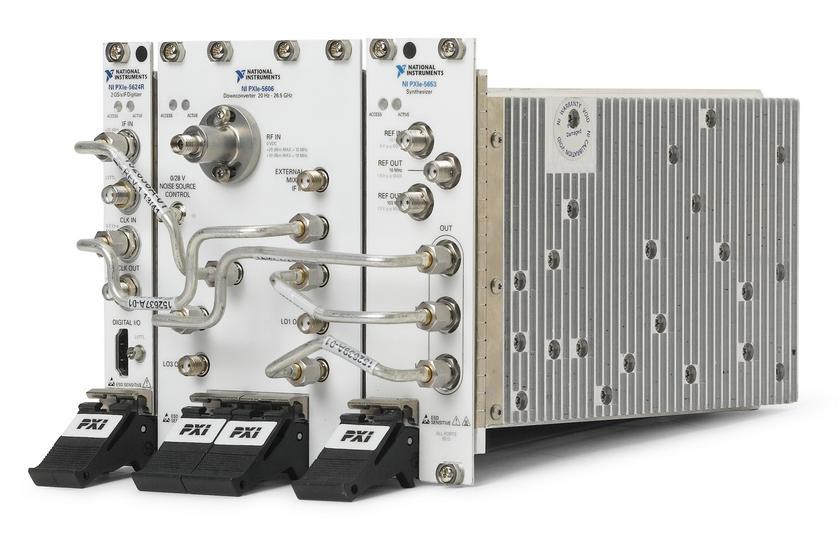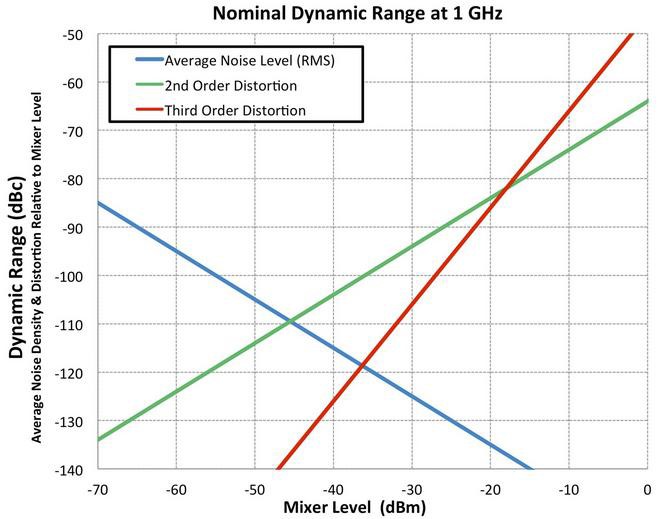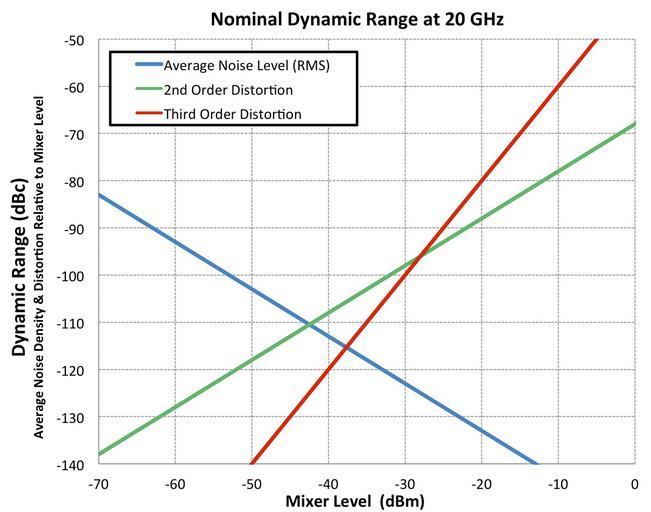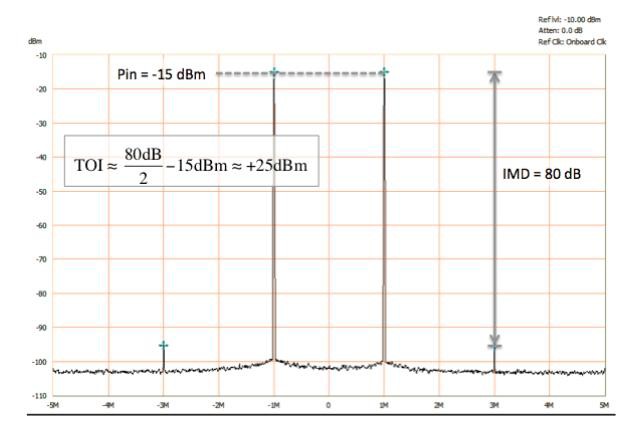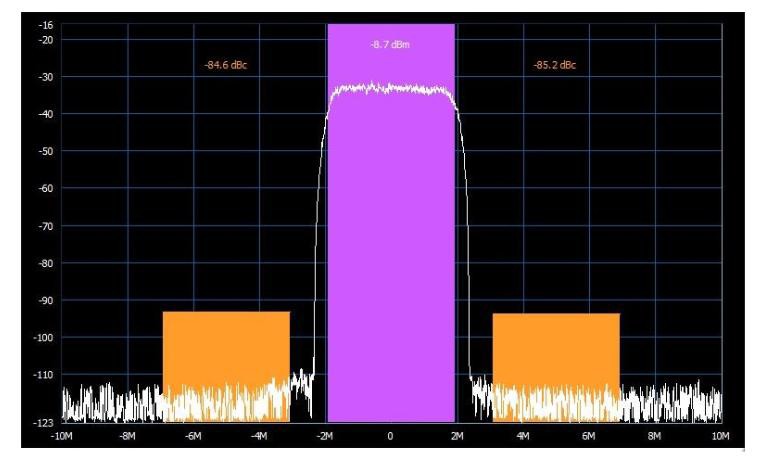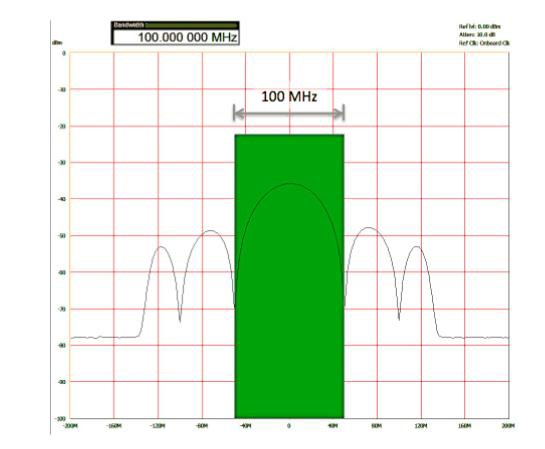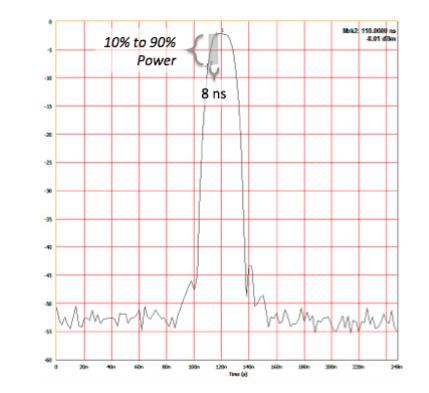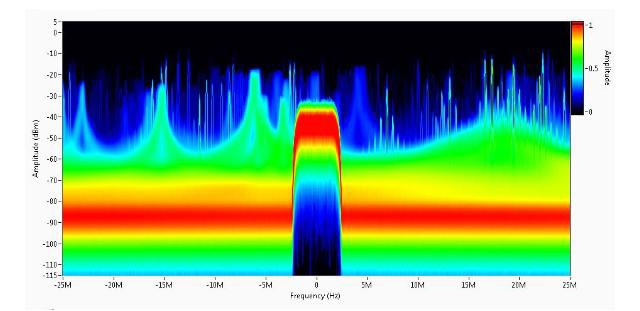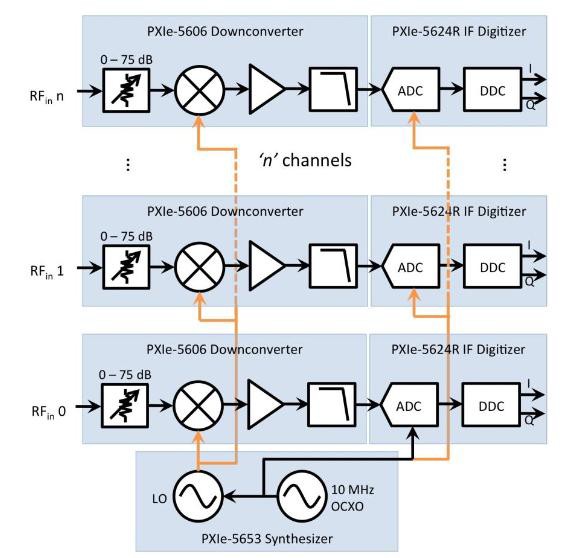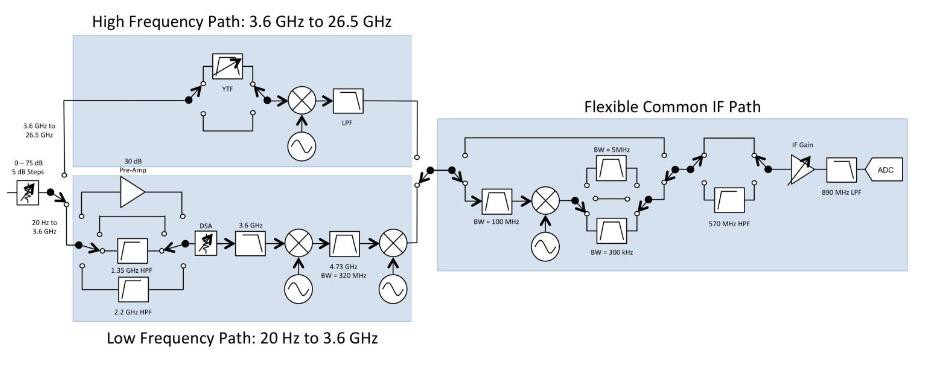Introduction to the PXIe-5668 - High Performance 26.5 GHz Wideband Signal Analyzer
Overview
The PXIe-5668 vector signal analyzer (VSA) offers 765 MHz of bandwidth with best-in-class measurement performance and speed. This high-performance microwave signal analyzer meets the challenging requirements of applications such as wireless communications, radio frequency integrated circuit (RFIC) characterization, Radio Detection And Ranging (RADAR) test, and spectrum monitoring/signal intelligence.
Contents
- RF Measurement Performance
- Wide Instantaneous Bandwidth
- Flexibility
- Architecture
- Flexible IF Structure
- Summary
Figure 1. PXIe-5668 VSA
The PXIe-5668, shown in Figure 1, offers a unique combination of RF measurement performance, measurement speed, and flexibility. With industry-leading dynamic range and bandwidth, this instrument is an ideal solution for the challenging measurement requirements of R&D applications. With its implementation as a PXI instrument, the PXIe-5668 also features the fast measurement speed required for high-volume manufacturing test. Finally, this VSA includes a LabVIEW-programmable Xilinx Kintex-7 FPGA that you can use to customize the instrument’s behavior by adding triggering or signal-processing routines.
RF Measurement Performance
The PXIe-5668 is a PXI fast Fourier transform (FFT)-based signal analyzer suitable for both high-end spectrum analysis and vector signal analysis. The combination of low phase noise, low noise floor, and high second- and third-order intercepts provides excellent dynamic range for applications ranging from adjacent channel leakage ratio (ACLR) measurements to spurs and harmonics measurements. Table 1 illustrates the typical performance of the PXIe-5668 at center frequencies of 1 GHz and 20 GHz.
| 1 GHz | 20 GHz | |
Noise Floor (RMS) Without PreAmp Noise Floor (RMS) PreAmp | -155 dBM/Hz -166 dBm/Hz | -152 dBm/Hz - |
Third Order Intercept (TOI) | +24 dBm | +25 dBm |
| Second Harmonic Intercept (SHI) | +75 dBm | N/A |
| Image Rejection | -102 dBc | -83 dBc |
| Phase Noise at 10 kHz Offset | -129 dBc/Hz | -116 dBc/Hz |
| Instantaneous Bandwidth | 320 MHz | 765 MHz |
Dynamic Range [2/3*(TOI-DANL)] | 119 dB | 118 dB |
Table 1. Typical PXIe-5668 Performance
The PXIe-5668 achieves extremely wide instantaneous bandwidth using its 2 GS/s digitizer. As Table 1 shows, the instrument features 320 MHz of instantaneous bandwidth below center frequencies of 3.6 GHz and up to 765 MHz of instantaneous bandwidth at center frequencies from 3.6 GHz to 26.5 GHz.
Dynamic Range
The excellent dynamic range performance of the PXIe-5668 gives it the ability to accurately perform measurements ranging from intermodulation distortion (IMD) to adjacent channel power (ACP) to error vector magnitude (EVM). In Figures 2 and 3, the instrument’s dynamic range chart illustrates both noise and linearity as a function of mixer level.
Figure 2. PXIe-5668 Dynamic Range chart at 1 GHz
Figure 3. PXIe-5668 Dynamic Range Chart at 20 GHz
In Figure 2, note that the optimal mixer level for most measurements is approximately -36 dBm, where the instrument delivers approximately 117 dB of spurious free dynamic range (SFDR) in a 1 Hz bandwidth. At 20 GHz (Figure 3), the PXIe-5668 achieves similar performance with an optimal mixer level of -37 dBm. At this mixer level, the instrument achieves 115 dB of SFDR in 1 Hz of bandwidth.
A combination of excellent linearity and noise floor is critical when measuring IMD and ACP. In fact, the specification that best represents the ability of an instrument to perform these measurements is third-order intercept (TOI). The PXIe-5668 has a TOI specification of better than +23 dBm at 1 GHz with 0 dB of attenuation. As Figure 4 illustrates, the instrument delivers nominal TOI performance of +25 dBm at 1 GHz,2 dB better than specification.
Figure 4. PXIe-5668 Intermodulation Distortion Measurements
Although the TOI specification of an RF signal analyzer is defined using 0 dB of attenuation by convention, an RF signal
analyzer can measure TOI much higher than its specification. In practice, you can optimize measurement system linearity by switching up to 75 dB of internal attenuation on the PXIe-5668.
In addition to IMD measurements, the high dynamic range of the PXIe-5668 makes it ideal for spectrum measurements such as ACP and ACLR. Figure 5 illustrates an ACLR measurement of a WCDMA signal and shows an inherent ACLR floor of approximately 85 dB.
Figure 5. PXIe-5668 WCDMA ACLR Perofrmance at 468 MHz
In addition to making UMTS ACLR measurements, you can also use NI wireless standards software toolkits in conjunction with the PXIe-5668 to test devices using technologies including GSM/EDGE, UMTS/HSPA+, LTE/LTE Advanced, Bluetooth, and 802.11a/b/g/n/p/ac.
Wide Instantaneous Bandwidth
The PXIe-5668 supports an instantaneous bandwidth of 320 MHz or 765 MHz, depending on frequency range. The ability to measure extremely wide bandwidths in a single acquisition is useful for applications ranging from wireless communications test to radar pulse measurements. When measuring wideband signals with metrics such as EVM, the instantaneous bandwidth of the RF signal analyzer must be greater than the bandwidth of the signal. For example, wireless technologies such as the IEEE 802.11ac standard require an instantaneous bandwidth of 160 MHz to perform an EVM measurement. In addition, the spectrum mask requirements for a 160 MHz 802.11ac signal include limits that are 240 MHz from the center frequency for a total of 480 MHz of bandwidth. With 765 MHz of instantaneous bandwidth, the PXIe-5668 can perform measurements such as a 160 MHz spectrum mask in a single acquisition.
Additional applications such as RADAR pulse measurements also require extremely wide instantaneous bandwidth. In a typical radar pulse, the frequency domain characteristics of the signal appear as a sync function containing both a main lobe and theoretically infinite side lobes as shown in Figure 6.
Figure 6. The main power lobe of a 20 ns pulse contained within a bandwidth of 100 MHz.
RADAR pulse measurements, such as pulse rise time, require a VSA to capture both the main lobe and several side lobes. A general rule for measuring the pulse rise time of X nanoseconds is that the instrument’s instantaneous bandwidth must be 3/X. For example, to measure pulse rise times as low as 5 ns, the required instrument instantaneous bandwidth would be 3 / (5 ns) or 600 MHz. In Figure 7, notice that the wide bandwidth of the PXIe-5668 signal analyzer enables extremely accurate pulse rise time measurements – in this case showing a rise time of 8 ns.
Figure 7. Time Domain of a 20 ns Pulse Using Zero Span Mode
Although the extremely wide bandwidth of the PXIe-5668 is ideal for performing accurate pulse measurements, the wide instantaneous bandwidth also allows faster spectrum measurements in scenarios where the span is smaller than the instantaneous bandwidth of the instrument.
Flexibility
A final key attribute of the PXIe-5668 RF signal analyzer is the flexibility with which you can reconfigure it. Because the PXIe-5668 is a LabVIEW FPGA programmable target, you can embed custom signal processing algorithms on the instrument itself. For example, using LabVIEW example code, you can configure the instrument as a real-time spectrum analyzer (RTSA). As shown in Figure 8, with the RTSA personality, you can analyze extremely wide bandwidths of spectrum in real time without gaps in the time-domain record.
Figure 8. The real-time spectrum analysis capability of the PXIe-5668 enables unique visualization tools such as the persistence display
Finally, a result of this instrument’s modular architecture, additional downconverter and digitizer modules support multichannel receiver configurations. The PXIe-5668 VSA provides the ability to share the local oscillator (LO) and other timing signals across multiple modules and allows for phase-coherence between each RF channel. The phase-coherence of multichannel receivers is important in applications ranging from direction finding to beamforming and multiple input, multiple output (MIMO) device testing. Figure 9 shows an example configuration of a 2-channel RF signal analyzer.
Figure 9. You can configure multiple PXIe-5668 Instruments for multichannel, phase-coherent RF signal acquisition.
Using the configuration shown in Figure 9, you can achieve tight channel-to-channel synchronization in multichannel measurement applications.
Architecture
The PXIe-5668 uses two distinct signal paths to deliver a combination of wide instantaneous bandwidth and best-in-class RF performance. In the low-band path below 3.6 GHz, the instrument uses a three-stage superheterodyne design with optional preamplification. In the high-band path, above 3.6 GHz, the instrument uses a two-stage design with a yttrium-iron-garnet (YIG)-tuned filter (YTF) for preselection.
In the low band of the PXIe-5668 (below 3.6 GHz), the instrument contains several features to improve measurement performance. Figure 10 highlights a simplified block diagram. Here, notice that you can engage the 30 dB preamplifier to reduce the instrument’s inherent noise floor when measuring low-level signals.
Figure 10. Simplified Block Diagram of PXIe-5668
Figure 10 also illustrates two high-pass filters before the first mixing stage. You can engage these filters with a high-pass cutoff of 1,350 and 2,200 MHz to suppress fundamental frequency of common cellular communications bands around 1 GHz. With filters enabled, the instrument can more accurately measure low-level second and third harmonics at approximately 2 GHz and 3 GHz, respectively.
In the high band, above 3.6 GHz, a YTF functions as a preselector for operation from 3.6 GHz to 26.5 GHz – which is enabled by default for spectrum measurements. For extremely wideband vector signal analysis, one can disable the YTF to utilize the full 765 MHz of instrument bandwidth.
Flexible IF Structure
In conjunction with a 2 GS/s digitizer sample rate, the VSA’s downconverter has a flexible IF structure that allows both high-end spectrum analysis and wideband vector signal analysis. For example, you can engage a narrow 300 kHz analog filter to facilitate measurements requiring the highest dynamic range—such as two-tone intermodulation distortion (IMD) or ACLR. For vector signal analysis, you can disable the IF filtering entirely to allow for bandwidths of up to either 320 MHz or 765 MHz, depending on the center frequency.
The PXIe-5624 digitizer’s wideband analog front end is optimized for superheterodyne receiver architectures. It features an onboard digital downconverter (DDC), which converts IF signals to IQ data. As a result, you can use the PXIe-5624 either as part of the PXIe-5668 VSA or as a standalone IF digitizer.
Summary
The PXIe-5668 is a high-performance 26.5 GHz VSA that is ideal for a wide range of applications. The combination of excellent analog performance, extremely wide bandwidth, and ultimate flexibility empower you to solve challenging measurement applications ranging from ACLR measurements to radar verification to spectrum monitoring.
